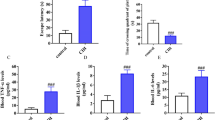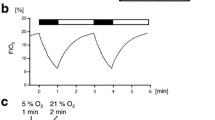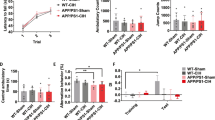Abstract
Background
Obstructive sleep apnea (OSA) is a common disorder that is associated with increased cerebrovascular disease and neurocognitive impairment. Although reports on cardiovascular and cerebrovascular morbidity have been conducted, there are few research on the mechanism related to cognitive decline and dementia especially, Alzheimer’s disease (AD). Recent study reinforces OSA-AD link with amyloid deposition in the OSA brain and APOE genotype prevalence in OSA. This study is designed to find a link between OSA and neurodegenerative with successful animal model setting.
Methods
A total of 16 rats were used, divided into the control and OSA group. For OSA, 0.3% cross-linked hyaluronic acid was injected twice every 12 weeks into the base of the tongue to create an OSA model. After 12 and 24 weeks, chronic OSA was identified with full channel polysomnography (PSG). The Morris water maze (MWM) test was conducted in control and OSA groups at 22 weeks, and pathological findings were subsequently confirmed 24 weeks after OSA induction. In addition, we studied the epigenetic changes with miRNA to identify the biomarkers for the prediction of dementia in OSA.
Results
In the MWM test, the speed of finding the platform was lower than that of the control group (47.0 ± 13.9 s; OSA group/12.4 ± 6.1 s; control, p < 0.01). In brain histopathologic changes, disorganized cortex layers in OSA group were prominent compared with the control cortex. Hippocampal cortex in OSA also showed a disorganized CA1 region with degenerative neurons and fibrillary changes, compared with the control. The miRNA analysis identified an up-regulation in MiR-132-5p/137-3p/137-5p/501-3p, also known as AD, and a down-regulation of MiR-182/183-3p/183-5p/200a-3p/200b-3p/21-5p.
Conclusion
OSA rat model with tongue hypertrophy showed neurodegenerative changes in brain and the epigenetic changes of mRNA/miRNA which have been known as AD-related genes.








Similar content being viewed by others
References
Aleksandra M et al (2021) The role of screening questionnaires in the assessment of risk and severity of obstructive sleep apnea—polysomnography versus polygraphy. Adv Respir Med 89(2):188–196
Ancoli-Israel S et al (2008) Cognitive effects of treating obstructive sleep apnea in Alzheimer’s disease: a randomized controlled study. J Am Geriatr Soc 56(11):2076–2081
Bagaria J et al (2021) Importance of GWAS in finding un-targeted genetic association of sporadic Alzheimer’s disease. Mol Cell Toxicol 17:233–244
Castro-Grattoni AL et al (2019) Effect of age on the cardiovascular remodelling induced by chronic intermittent hypoxia as a murine model of sleep apnoea. Respirology 25(3):312–320
Chung HK et al (2019) Chronic exposure to ethylenethiourea induces kidney injury and polycystic kidney in mice. Mol Cell Toxicol 15:57–63
Cui GH et al (2018) Exosomes derived from hypoxia-preconditioned mesenchymal stromal cells ameliorate cognitive decline by rescuing synaptic dysfunction and regulating inflammatory responses in APP/PS1 mice. FASEB J 32(2):654–668
Daulatzai MA (2017) Cerebral hypoperfusion and glucose hypometabolism: key pathophysiological modulators promote neurodegeneration, cognitive impairment, and Alzheimer’s disease. J Neurosci Res 95(4):943–972
Elias A et al (2018) Risk of Alzheimer’s disease in obstructive sleep apnea syndrome: amyloid-beta and tau imaging. J Alzheimers Dis 66(2):733–741
Emamian F et al (2016) The association between obstructive sleep apnea and Alzheimer’s disease: a meta-analysis perspective. Front Aging Neurosci 8:78
Gaspar LS et al (2017) Obstructive sleep apnea and hallmarks of aging. Trends Mol Med 23(8):675–692
Gildeh N et al (2016) Emerging co-morbidities of obstructive sleep apnea: cognition, kidney disease, and cancer. J Thorac Dis 8(9):e901–e917
He D, Tan J, Zhang J (2017) miR-137 attenuates Aβ-induced neurotoxicity through inactivation of NF-κB pathway by targeting TNFAIP1 in Neuro2a cells. Biochem Biophys Res Commun 490(3):941–947
Heinzer R et al (2015) Prevalence of sleep-disordered breathing in the general population: the HypnoLaus study. Lancet Respir Med 3(4):310–318
Ioachimescu OC, Collop NA (2012) Sleep-disordered breathing. Neurol Clin 30(4):1095–1136
Jawaid A et al (2019) Memory decline and its reversal in aging and neurodegeneration involve miR-183/96/182 biogenesis. Mol Neurobiol 56(5):3451–3462
Kerner NA, Roose SP (2016) Obstructive sleep apnea is linked to depression and cognitive impairment: evidence and potential mechanisms. Am J Geriatr Psychiatry 24(6):496–508
Kim H, Han HJ (2016) The effect of rivastigmine transdermal patch on sleep apnea in patients with probable Alzheimer’s disease. Dement Neurocogn Disord 15(4):153–158
Kim JY et al (2018) Distinct amyloid precursor protein processing machineries of the olfactory system. Biochem Biophys Res Commun 495(1):533–538
Kim H et al (2022) The positive effects of Poria cocos extract on quality of sleep in insomnia rat models. Int J Environ Res Public Health 19(11):6629
Kong Y et al (2015) High throughput sequencing identifies microRNAs mediating α-synuclein toxicity by targeting neuroactive–ligand receptor interaction pathway in early stage of Drosophila Parkinson’s disease model. PLoS ONE 10(9):e0137432
Liu H et al (2015) Folic acid deficiency enhances abeta accumulation in APP/PS1 mice brain and decreases amyloid-associated miRNAs expression. J Nutr Biochem 26(12):1502–1508
Lutsey PL et al (2018) Sleep characteristics and risk of dementia and Alzheimer’s disease: the atherosclerosis risk in communities study. Alzheimers Dement 14(2):157–166
Mansukhani MP et al (2019) Hypertension and cognitive decline: implications of obstructive sleep apnea. Front Cardiovasc Med 6:96
Moreno-Indias I et al (2015) Intermittent hypoxia alters gut microbiota diversity in a mouse model of sleep apnoea. Eur Respir J 45(4):1055–1065
Mubashir T et al (2019) The prevalence of obstructive sleep apnea in mild cognitive impairment: a systematic review. BMC Neurol 19(1):195–195
Peppard PE et al (2013) Increased prevalence of sleep-disordered breathing in adults. Am J Epidemiol 177(9):1006–1014
Shaltiel G et al (2013) Hippocampal microRNA-132 mediates stress-inducible cognitive deficits through its acetylcholinesterase target. Brain Struct Funct 218(1):59–72
Sunwoo JS et al (2018) Prevalence, sleep characteristics, and comorbidities in a population at high risk for obstructive sleep apnea: a nationwide questionnaire study in South Korea. PLoS ONE 13(2):e0193549
Thomson C et al (2022) Association between risk of obstructive sleep apnea, inflammation and cognition after 45 years old in the Canadian longitudinal study on aging. Sleep Med 91:21–30
Toyama K et al (2018) MicroRNA-mediated therapy modulating blood–brain barrier disruption improves vascular cognitive impairment. Arterioscler Thromb Vasc Biol 38(6):1392–1406
Wang L et al (2019) MicroRNA-200a-3p mediates neuroprotection in Alzheimer-related deficits and attenuates amyloid-beta overproduction and Tau hyperphosphorylation via coregulating BACE1 and PRKACB. Front Pharmacol 10:806
Yu MS et al (2014) An animal model of obstructive sleep apnea in rabbit. Laryngoscope 124(3):789–796
Yun CH et al (2017) Amyloid burden in obstructive sleep apnea. J Alzheimers Dis 59(1):21–29
Zhang QS et al (2017) miR-200a-3p promotes b-amyloid-induced neuronal apoptosis through down-regulation of SIRT1 in Alzheimer’s disease. J Biosci 42(3):397–404
Acknowledgements
This study was carried out with the support of ‘R&D Program for Forest Science Technology (Project No. 2020196D10-2222-BA01, 2021389B10-2223-0102)’ provided by the Korea Forest Service (Korea Forestry Promotion Institute). This research was supported by “Regional Innovation Strategy (RIS)” through the National Research Foundation of Korea (NRF) funded by the Ministry of Education (MOE) (2022RIS-005).
Author information
Authors and Affiliations
Corresponding authors
Ethics declarations
Conflict of interest
Hyeyun Kim, Ju Yeon Pyo, Jiyeon Moon, Seungeun Lee, Minchae Kim, Yein Choi, Dong-Ick Shin4, Byong-Gon Park declares that they have no conflict of interest.
Ethical approval
This study was conducted under the supervision and approval of the Animal Ethics Committee for the maintenance and management of animals, and certain temperatures, humidity, diet, and water supply were conducted. All experiments were carried out in accordance with “Care and Use of Laboratory Animals” published by the US National Institutes of Health, and the study was approved by the Committee for the Care and Use of Laboratory Animals at Catholic Kwandong University (2019-006). Procedures, manufacturing, and sacrifice processes were carried out in compliance with the three R principles of animal study (replacement, reduction, and refinement).
Additional information
Publisher’s Note
Springer Nature remains neutral with regard to jurisdictional claims in published maps and institutional affiliations.
Rights and permissions
Springer Nature or its licensor (e.g. a society or other partner) holds exclusive rights to this article under a publishing agreement with the author(s) or other rightsholder(s); author self-archiving of the accepted manuscript version of this article is solely governed by the terms of such publishing agreement and applicable law.
About this article
Cite this article
Kim, H., Pyo, J.Y., Moon, J. et al. Identification of miRNA expression associated with Alzheimer’s disease and neurodegeneration in rat models with obstructive sleep apnea. Mol. Cell. Toxicol. 19, 789–798 (2023). https://doi.org/10.1007/s13273-022-00309-y
Accepted:
Published:
Issue Date:
DOI: https://doi.org/10.1007/s13273-022-00309-y




